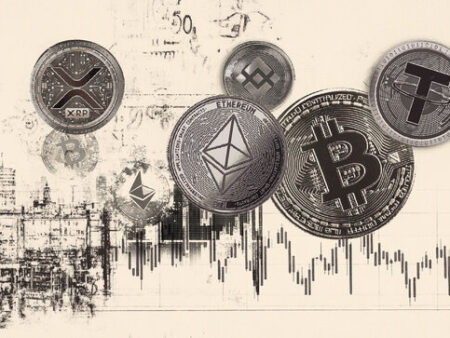Crypto Market Update: Bitcoin ETFs See Inflows, Ethereum Eyes Breakout
The cryptocurrency market is showing mixed signals, with Bitcoin’s recovery faltering below $110,000 ahead of the Federal Reserve (Fed) meeting minutes release. Ethereum, however, displays potential for gains above $3,000, fueled by institutional investor interest.
Fed Minutes Anticipated to Trigger Volatility
The minutes from the Federal Open Market Committee (FOMC) meeting in May are expected to be a focal point for global markets. Investors will be scrutinizing the minutes for insights into the committee’s monetary policy stance and potential future interest rate decisions.
Earlier this month, Fed Chair Jerome Powell noted that trade tensions could impact U.S. inflation. The FOMC minutes are likely to echo this sentiment, although markets may anticipate a less hawkish stance given potential tariff delays.
Institutional Investors Increase Crypto Holdings
Bitcoin spot Exchange Traded Funds (ETFs) have recorded nine consecutive days of net inflows, with approximately $385 million flowing into these products on Tuesday. BlackRock’s IBIT ETF led with $409 million in daily net inflows, followed by Grayscale Bitcoin Mini Trust with $36 million, and VanEck’s HODL with $7.77 million. Bitwise’s BITB also saw $1.79 million in net inflows. Other ETFs, including Fidelity’s FBTC, Grayscale’s GBTC, and Ark & 21Shares’ ARKB, experienced net outflows.
Ethereum spot ETFs also saw inflows, totaling $38.77 million on Tuesday, marking seven consecutive days of inflows. BlackRock’s ETHA accounted for the largest share, with $32.5 million, followed by Fidelity’s FETH and VanEck’s ETHV.
BlackRock’s Strategic Income Opportunities Portfolio held approximately 2,123,592 shares of the iShares Bitcoin Trust (IBIT) as of March 31, valued at around $99.4 million, an increase from 1,691,143 shares as of December 31. This actively managed bond portfolio primarily invests in diversified fixed-income securities.
Trump Media & Technology Group recently announced a Bitcoin treasury worth $2.5 billion following agreements with institutional investors to issue and sell common stock and senior convertible notes. The company stated that investing in Bitcoin aligns with its “America First” principles.
Market Sentiment Remains Greedy
The cryptocurrency market sentiment remains in “greed” territory, according to the Crypto Fear & Greed Index, which currently stands at 71, up from a “neutral” 54 last month.
The Fear & Greed Index suggests that investor behavior shapes market trends. Investors tend to be greedy when prices are rising, reflecting a fear of missing out (FOMO). Conversely, investors tend to sell irrationally when prices are falling, indicating fear. The platform suggests considering selling during periods of “extreme greed” and buying when the market experiences “extreme fear.”
According to IntoTheBlock’s In/Out of the Money Around Price (IOMAP) model, over 90% of Bitcoin holders are in profit, with only 9.53% experiencing unrealized losses. Most liquidity lies below the current market price, suggesting that Bitcoin is more likely to extend its uptrend than to correct sharply.
Bitcoin Consolidates Below $110,000 Resistance
Bitcoin is currently trading around $108,820, supported by the 50-period Exponential Moving Average (EMA) on the 4-hour chart at $108,235.
While Bitcoin remains above key support areas, including the 100-period EMA at $106,109 and the 200-period EMA at $101,927, downside risks persist.
A sell signal confirmed by the Moving Average Convergence Divergence (MACD) indicator could encourage traders to reduce their Bitcoin exposure, increasing selling pressure. Expanding red histogram bars below the midline suggest potential bearish momentum.
The Relative Strength Index (RSI) is trending downward, currently below the 50 midline, indicating potential bearish momentum.
Ethereum Eyes Breakout from Rectangular Pattern
Ethereum continues its consolidation within a rectangular pattern. Downside risks remain evident, especially after Ethereum’s rejection at the pattern’s upper limit around $2,716.
If the MACD indicator validates a sell signal, the path of least resistance could remain downward. This signal could make short positions in Ethereum attractive to traders, contributing to selling pressure.
The sharp decline in the RSI from near overbought conditions indicates that buyers are losing momentum.
However, the rectangle is a bullish pattern, which, if validated, could propel Ethereum’s price 14% above the breakout point (the upper limit) to $3,096.
A surge in trading volume often accompanies such a breakout. The breakout target is determined by measuring the width of the rectangle and extrapolating it above the breakout point.
Crypto Metrics FAQs
- What determines the total number of tokens for a cryptocurrency?
- How is market capitalization calculated?
- What is trading volume?
- What is the funding rate?
The developer or creator of each cryptocurrency decides the total number of tokens that can be minted or issued. Only a certain number of these assets can be minted through mining, staking, or other mechanisms. This is defined by the algorithm of the underlying blockchain technology.
Market capitalization is the result of multiplying the circulating supply of a particular asset by its current market value.
Trading volume refers to the total number of tokens of a specific asset that have been traded or exchanged between buyers and sellers within a set trading schedule, such as 24 hours. It is used to measure market sentiment, and this metric combines all volumes from centralized and decentralized exchanges. Increased trading volume often denotes demand for a particular asset, as more people are buying and selling the cryptocurrency.
The funding rate is a concept designed to encourage traders to take positions and ensure that the prices of perpetual contracts match those of spot markets. It defines a mechanism for exchanges to ensure that future prices and periodic price payments converge regularly. When the funding rate is positive, the price of the perpetual contract is higher than the market price. This means that traders who are bullish and have opened long positions pay traders who are in short positions. Conversely, a negative funding rate means that perpetual contract prices are lower than the reference price, so traders with short positions pay traders who have opened long positions.
Stay ahead of the curve in the fast-paced crypto world – explore the latest updates and trends at Cryptonewsfeeds.com.










